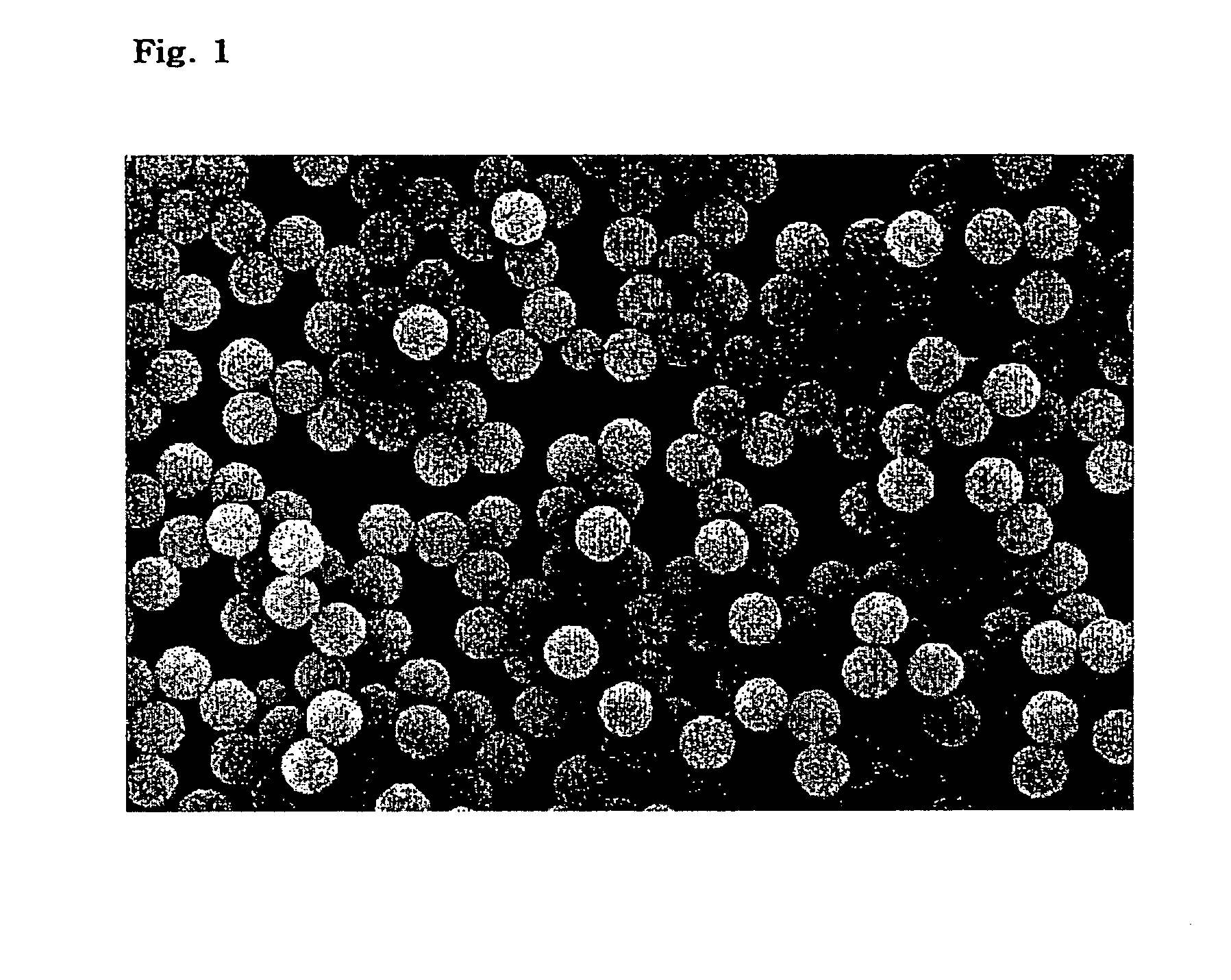Synthetic fiber containing powders with the shape of hollow sphere
a technology of synthetic fibers and powders, applied in the field of synthetic fibers including hollow sphere-shaped particles, can solve the problems of poor preparation process of fibers, heavy wearing of clothes made of such fibers, and many problems, and achieve the effect of convenient us
- Summary
- Abstract
- Description
- Claims
- Application Information
AI Technical Summary
Benefits of technology
Problems solved by technology
Method used
Image
Examples
example 1
[0026] From commercially available hollow silica spheres having an apparent specific gravity of 0.15 g / cc, an average particle size of 2 μm and 98% of SiO2, silica having small sizes were separated, which had an apparent specific gravity of 0.18 g / cc, an average particle size of 0.65 μm and a 90% particle size of 1.3 μm, and a maximum size of 2.2 μm.
[0027] Thusly separated hollow spheres were subjected to a master batch preparation process along with a polypropylene resin, to prepare a polypropylene master batch chip having 10 wt % of hollow silica spheres, which was then further mixed with a polypropylene resin and subjected to a synthetic fiber spinning process, thus preparing a polypropylene yarn of 1.2 denier containing 1.5 wt % of hollow silica spheres.
[0028] The prepared fiber had a density ratio of 0.96, in which a density ratio means a value obtained by dividing the specific gravity of a yarn containing hollow spheres by the specific gravity of a yarn containing elvan powd...
example 2
[0029] Through an emulsion polymerization, the microspheres of polystyrene having a uniform size were synthesized and separated from the emulsion (FIG. 1). Then, TEOS (Tetra Ethyl Ortho Silicate) was hydrolyzed and coated onto the microspheres, which were then dried. Internal polystyrene was dissolved in methylene dichloride to obtain hollow silica spheres (FIG. 2). As for the hollow silica spheres, particles had a uniform size and a diameter of 1.0 μm. To confirm the shape of these silica particles, the particles were destroyed and observed. From this, it can be seen that silica is in the shape of hollow spheres (FIG. 3).
[0030] The hollow spheres were subjected to the processes same as in example 1, to yield a polypropyele yarn of 1.2 denier containing 1.5 wt % of hollow silica spheres. The density ratio was 0.94.
example 3
[0031] Through a LBL (Layer By Layer) adsorption, 20 nm sized ultrafine particles of SiO2 were adsorbed three times to spherical polylatex particles, to obtain fine particles of polystyrene latex coated with ultrafine particles of SiO2, which were then heat-treated to remove an internal organic material. Thereby, SiO2 hollow spheres each having a diameter of 0.6 μm were obtained.
[0032] The hollow spheres were subjected to the processes the same as in example 1, to yield a polypropyele yarn of 1.2 denier containing 1.5 wt % of SiO2 hollow spheres. The density ratio was 0.96.
PUM
| Property | Measurement | Unit |
|---|---|---|
| specific gravity | aaaaa | aaaaa |
| size | aaaaa | aaaaa |
| particle size | aaaaa | aaaaa |
Abstract
Description
Claims
Application Information
 Login to View More
Login to View More - R&D
- Intellectual Property
- Life Sciences
- Materials
- Tech Scout
- Unparalleled Data Quality
- Higher Quality Content
- 60% Fewer Hallucinations
Browse by: Latest US Patents, China's latest patents, Technical Efficacy Thesaurus, Application Domain, Technology Topic, Popular Technical Reports.
© 2025 PatSnap. All rights reserved.Legal|Privacy policy|Modern Slavery Act Transparency Statement|Sitemap|About US| Contact US: help@patsnap.com



